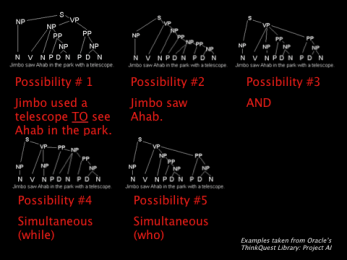Diagramming Sentences of Value: Evolving Human Rights and the Terms of Geoethical Nanotechnology
Wrye Sententia, Ph.D.
This article was adapted from a presentation given by Wrye Sententia, Ph.D. during Terasem Movement, Inc.'s 1st Annual Workshop on Geoethical Nanotechnology, July 20, 2005 at the Green Mountain Retreat in Lincoln, VT.
Dr. Wrye Sententia, Director of the Center for Cognitive Liberty and Ethics from 1999-2005, is currently a Professor at the University of California, Davis campus. Drawing from her well of cognitive and technological expertise, Wrye emphasizes the fundamental human right of freedom of thought without constraint within this age of interactive technologies.
Today, the technologies we have, and the questions they raise, are more groping, more comprehensive than at any other point in human history. They have become an integral part of who we are and what we do. Hannah Arendt said as much in the mid-century in her book, The Human Condition. [1] Nanoscale science, engineering, and medicine are poised to radically alter our current human condition. Now, I've been charged with providing a definition of geo-ethical nanotechnology, and I don't have one.
We have our puzzle pieces but they need to be seared together to solve this puzzle. I don't think we will solve it today; I don't think it will be tomorrow, but we need to make an attempt. We each approach puzzles in a different way. Some people go for the corner pieces; other people scuttle the pieces around until they fit. The goal is to end up with a completed puzzle, not a pile of unassembled parts, and not to have someone lock up your game in the process. We shouldn't be hoarding puzzle pieces, because the puzzle is constantly changing.
My particular interest in nanotechnology and in nanoscale science is in the area of cognition, accelerated cognition and communication in data processing, memory enhancement, neurodiagnostics, and nanomedicine. I do have concerns about nanoscale surveillance, about the loss of autonomy, not just for my own personal decision-making capabilities, but also for those who have had their decisions already diminished, those who have less of a voice in what's going on in the rapid acceleration of techno-culture.
The Center for Cognitive Liberty and Ethics [2] set out as its mission to protect and promote freedom of thought in an age of interactive technologies—at a time when we are interacting with the brain on the literal and quite technical level. Freedom to think without constraint is a fundamental human right and evolutionary necessity.
Language offers a kind of linguistic puzzle that affects how we think and how we act. Historically speaking, sentences came before paragraphs, but after words. Sentences are also an analog. There are analogues to "sentences" in mathematical formulations, informal logic, and computer programming, and of course in the law, in passing judgment, and in claiming a (juridical) sentence. We are currently at the sentence level in terms of geophysics: after words, but before paragraphs. We have some of the terms on the table. We have some of the concerns about the science getting airtime in the public sphere, but we don't quite know how the science is going to fit into our larger social and semantic systems, nor do we know how to bring about the most benefits and inhibit the most harm.

Most people's default form of expression is to run on autopilot, which tends to bifurcate into binary decision-making: linear questions lead to linear results. It's like the grocery store question, "Would you like paper or plastic?" Inevitably you choose one and you're never quite sure which one is hurting the environment or if you've done the right thing. I'd like to put the idea forth of syntax—patterns of relation in sentences, and semantics—patterns of meaning. When linguists think about diagramming sentences, we look for structural building blocks. In this instance, we have a simple sentence: "We have made progress." There is a noun, there is a verb; there are objects and verbs. It leads to a straightforward meaning, provided that you agree with the semantics (or meaning) of the sentence. But you don't necessarily have to agree, to see the logic of the sentence. This is a sort of grammatical capital coming into effect. It's straightforward and there is not much disagreement about it.
'If-then' sentences are a form of binary thinking that comes up a lot in ethical discussions. There is a deceptively simple pattern to them. Consequential relationships are built and coerced by the grammar of 'if-then'. In computer programming, you also have 'if-then-else' logic. Sequential relationships in programming, as I understand it, are built and coerced by the grammar of 'if-then-else' logic. In branching logic, with nested "if" codes, these are constrained by conditions that determine results: if-then-else. I want to put on the table today an upheaval in thinking about how the cultural, the nested cultural, social and ethical "if" clauses can be productively leveraged to improve the human condition along with the syntax of science.
Social software is buggy. We can't easily reach a consensus. The processing power that we are able to collectively amass helps—whatever the field and, objectively, with good design strategies, we reach solutions, but objectivity is not something that we can ever really achieve in social spheres. Such objectivity is not in the fleshy, fallible, human sphere. So, whereas an if-then-else logic does work for design, it doesn't work well for ethics and it doesn't work well for forecasting the future of society because ethics takes place in a geopolitical matrix that's constantly changing and is unpredictable, unmanageable, and repeatedly subject to human variables.
I want to argue for proactive social engineering. The Proactionary Principle [3] fits well with my thinking right now in this area, and I will adopt that phrase into my lexicon. We should think about how to engage these abstract values, things like cognitive liberty and terms like human freedom, as we build thought into action with the assistance of technology.
Returning to the linguistic metaphor and slides: we can see that a straightforward sentence such as this one, has a noun, a verb and a couple of prepositional phrases. If you parse this sentence structurally, "Jimbo saw Ahab in the park with a telescope" in this first way, then you know from the syntactical logic, that Jimbo used a telescope to see Ahab in the park. Pay attention to D; D is the determiner in what these sentences mean. If you read it in the second way, then Jimbo saw Ahab and that's all you know about Jimbo. Also, incidentally, from studying this possible structure, we can figure that Ahab was probably doing something with a telescope, and that he was in the park.
If you have what's called a conjunctive, (a word or expression acting as a conjunction) then, you have possible at the same time, two different versions of simultaneous, shown by the last two examples. Concretely, the sentence reads exactly the same as before. However, constructively, supported by syntax but on the level of semantics, the meaning shifts in the different possible ways that you parse it. I'm not suggesting going on to the relativist side of the aisle, where everything is arbitrary and nothing is fixed, because objectively, the sentence is the same on a structural, design level.
It has been said that the ethics of nanotechnology and the dizzying complexities with which we are faced – convergent technical issues, scientific issues, and social issues – reflect a diversity as extensive as our planet. This complexity is just as diverse as our language systems, as our embedded, or nested values.
I'd like to make an assertion about proclaimed advocates and self-conscious advocates of geo-ethical nanotechnology: we each have strong values that we bring to the table. From the Extropy Institute, [4] from the World Transhumanist Association, [5] from the Center for Responsible Nanotechnology [6] nation, and then extending it out to the larger global community to ETC [7] for the environment, to the President's Council on Bioethics [8] with their own insights and agendas, and to the National Nanotechnology Initiative, [9] the Department of Commerce and all other players who are speaking up in the discussion of nanoscience and nanoethics – they each have strong values to bring to the table.
Can we collectively affirm nested values for the future that will work together? Can we? Why should we? I'm a big fan of emerging ethics. Emerging ethics requires that we pull back from our binary thinking, from our own 'if-then' logic. We need new paradigms. We need new alliances, strategic ones that are contingent. The Converging Technologies Report [10] of the National Nanotechnology Initiative includes a clause, specifically on improving human performance that suggests that ethics is a necessary component to the discussion of nanoscience and nanoscale engineering. But what is proper attention? It's obvious that the difficulty is in managing competing interests, managing different desires, and different needs.
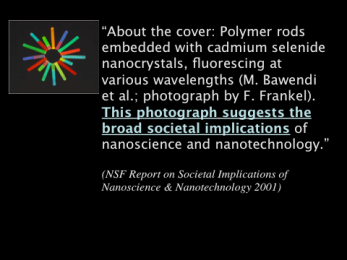
The issue of ethics was on the table for the National Science Foundation [11] at least a year before this Converging Technology Report, and it came up in the report on the societal implications of nanoscience. This image is from that report (it was on the cover): "Polymer rods with cadmium selenide nanocrystals, luorescing at various wavelengths. This photograph suggests the broad societal implications of nanoscience and nanotechnology." Does it? Not to everyone! Symbolism matters. Furthermore, in California, something like this rainbow does not evoke the "broad societal implications of nanoscience" but the rainbow is a symbol of gay, lesbian and queer-friendly culture. I'm sure that's not quite what the National Science Foundation intended.
I would like to focus briefly on two attempts at international dialogue on ethics that have come up in the last few years. In October 2004 ICON, the International Council of Nanotechnology [12] held its first meeting at Rice University.
One of the groups that was invited and did not go was the ETC (Action Group on Erosion, Technology and Concentration). ETC has made a lot of visible impact on the debates over nanotechnology, particularly with the call for a moratorium on research and their subsequent reports on the damaging effects. So why did ETC and the two other groups from Washington DC decline formal participation in the forum? Well, they cited a conflict of interest in the organization's structure, a corporate-driven research agenda and the issue of the sponsorship: who was paying for it? Pat Mooney [13] of the ETC criticized the word "international" in the name because he saw the sponsors and he said, "It doesn't cut it to have Mitsubishi from Japan and L'Oreal from France. Two-thirds of the globe is left out in the process."
Another complaint was that ICON needed to include more stakeholders, more people from academia, more trade unions, more developing countries and a similar desire for the inclusion of more voices by the Europeans. OK, this is my Bill McKibben [14] moment: Will enough stakeholders ever be enough stakeholders? I'm not certain. This is another group that has some international pretensions to open dialogue and have convened stakeholders, but I'm not going to go into it. They too raise international concerns that most of us are familiar with, which brings us to another Bill McKibben moment. When are enough dialogues going to reach enough ethics? At what point will we be able to say, "Now we've got it, now we can make a decision"?
Affirmations affect applied ethics. It's not enough to say that you love me. You've got to show it. So we need to move from an 'if-then' simple syntax to if-then complex syntax for ethics. I'd like to look at some strategies that don't seem to work, and some strategies that I think can.
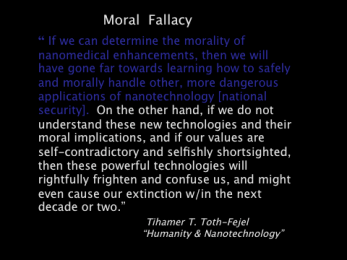
The first example I will show you is from a person who I believe was at the 2004 WTA conference in Toronto. His position seems to mimic the President's Council on Bioethics, calling for an ethical language that's without distortion and that somehow reaches a moral point that becomes perfectly clear. I'm confused by this language – but that's another issue.
It's not merely conservative bioethicists who are using this kind of fallacy in an 'if-then' moment. It's also the rationalists. It yearns: If we can determine the morality, then we can act, then we can know. It too yearns: If we could agree as a species, on what we wanted, where we were headed and why, then we could make our future much less dangerous. Then we might understand what we can and should relinquish. There is an odd confidence, a utopian wish that language reveal itself as transparent—capable of being pinned down, and in species agreement, but we can't even agree on what a species is—it's specious I guess.
So, why bother with abstract values like cognitive liberty? Because nested values are the diagrammed part of reality, the sentence diagram that you don't see supporting the meaning, the semantics of our world. Nested values can change people's attitudes and actions. Just as nanotechnology changes the property of matter at a scale that we can't see, so can affirming ethical values. Here is my if-then-else elliptical move: If at the center of nanotechnology applications, we can attach a language of freedom, a language of human rights, then we can shift the ways that society will respond to nano-scale science. But, not necessarily in a direct, linear fashion.
Diagramming social change takes parsing at a scale that's not measurable by the naked eye. Now this is really weird—why do I have an example of Queer Eye for the Straight Guy on my slide show in a discussion of nanotechnology? Because this is just one example, and there are countless other examples of what are called "speech acts," of creating action through words.
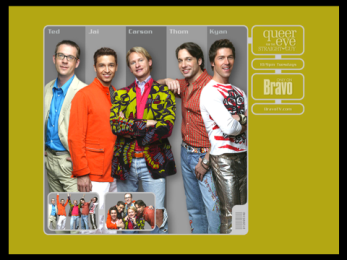
When a priest pronounces you married and you act that way, the state gives you benefits and others react to you that way: there is a speech act that has been committed. The priest has made you married. It's the same thing when a cop yells after you as you're going down the street and you see him: "Hey, you," the cop yells, and you either turn or run. That kind of speech act depends on how you approach the law—on how you view the speech act and whether you feel that it applies to you.
So a speech act serves a real function on how we behave. Language goes even further. Judith Butler [15] is a UC Berkeley professor who studies how we "perform" our own identity – specifically, how we perform acts of gender. She talks about how gender is produced over time and through repetition. It starts with babies. You get pink or blue, and you get pink or blue until you are blue in the face. It's a ritualized act of identity. The stronger the effects of repeated affirmations, the stronger the feedback in social environments, and the stronger the influence will be on how we behave.
Queer Eye for the Straight Guy is a reality show on Bravo TV. There are five gay guys with taste, and one straight guy without any. What they do is an extreme makeover on "straight guy" fashion, food, and design. They revisit all the aspects of the straight guy's environment in the span of a TV episode. At the same time that the gay makeover team is suggesting changes to improve the straight guy's taste, they respect the interests and values of the person who they're trying to help. Through this process, I see an extreme makeover of the mind: and it's not just superficial. It's not just the direct personal value for the straight guy, "Now I got taste, so I get the girl." It's not that, even though that's the level of appreciation that sometimes takes place.
There is an indirect social value. The viewing audience undergoes a transformation, a change that is facilitated by the TV broadcast, whereby they learn an increased tolerance, learn appreciation and understanding for something—gay culture--with which they may not have a direct relationship or access. In this show, there is an implied semantics subtext: that it's okay to have gay friends and "still" be straight. It's okay because we all are consumers. There is a cultural bridge through something that seems very superficial but that acts on a mental level.
So what does this have to do with geo-ethical nanotechnology? It has to do with taking language, doing acts of tangible good, even reengineering the word 'queer' here in the title to provoke intangible social change in different iterations of meaning.
We need to create sentences to parse out the geo-ethical puzzle and then to find places to deploy new meanings in the debate. Privacy, autonomy, and choice are values that we see embedded, nested, even within freedom of thought and autonomy. They are at the top of the list for the characteristics of life worth living.
To close, I would like to take the sentence back down to a physical reality. We have the backdrop, the diagram, and the design. But what can we do? In the year 2000, virtually all countries signed on to a global proclamation for the UN's Millennium Goals, which was an abstract statement that didn't exist before the year 2000, a way to make direct, tangible improvements in eight areas of human well-being for the world's poorest populations.
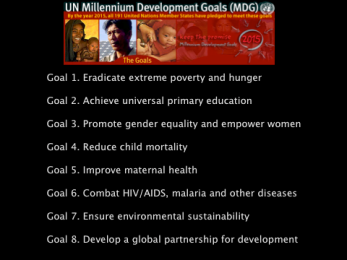
The Millennium Goal's progress report issued during 2004 showed that just the words of the proclamation have set a change in motion. There is increased equity for girls' education, improved literacy, and reductions in maternal mortality and issues in environmental sustainability. In Africa, in Southeast Asia, across the globe, these changes are taking place. But they are not far yet. They set a level of benchmark goals for the year 2015.
So what can nanotechnology do? 18% of the world's population, one billion people are without access to safe drinking water. One of the target goals of the UN is to cut this number in half worldwide by the year 2015. Let me just add that people who can't drink can't think, and can't think about freedom.
If the mega-minds of nanotechnology could get beyond the practical implementation of these eight goals, they would impact not only the poor, but they would have a marketing campaign to die for. It would mean global coverage. It could potentially shift the attitudes, the skepticism, the concern, and the suspicion of nanoscale engineering. This is Phase 1 of the future and I'm counting on us to create the second.
Endnotes & Citations
[1] The Human Condition – Hannah Arendt (1958). "The work of establishing the conditions of possibility for political experience, as opposed to other spheres of human activity."
Arendt, Hannah. The Human Condition. Illinois: University of Chicago Press, 1958.
http://www.iep.utm.edu/arendt/#H4 April 15, 2011 1:35PM EST
[2] Center for Cognitive Liberty and Ethics – "[A] network of scholars elaborating the law, policy and ethics of freedom of thought. Our mission is to develop public polices that will preserve and enhance freedom of thought into the 21st Century."
http://www.cognitiveliberty.org/index.html April 15, 2011 1:45PM EST
[3] Proactionary Principle - [I]mplies several imperatives when restrictive measures are proposed: Assess risks and opportunities according to available science, not popular perception.
http://www.extropy.org/proactionaryprinciple.htm June 1, 2011 10:05AM EST
[4] Extropy Institute – "[A] networking ideas exchange devoted to developing strategies for the future. Extropy is a symbol for continued progress and reflects the extent of a living or organizational system's intelligence, functional order, vitality, and capacity and drive for improvement. Extropy is an essential element of transhumanism."
http://www.extropy.org/About.htm April 15, 2011 1:55PM EST
[5] World Transhumanist Association – (known since 2009 as Humanity+) "[A]n international nonprofit membership organization which advocates the ethical use of technology to expand human capacities. We support the development of and access to new technologies that enable everyone to enjoy better minds, better bodies and better lives. In other words, we want people to be better than well."
http://transhumanism.org/index.php/WTA/hvcs/ and http://humanityplus.org/about/ April 15, 2011 2:06PM EST
[6] Center for Responsible Nanotechnology – "[A] non-profit research and advocacy think tank concerned with the major societal and environmental implications of advanced nanotechnology."
http://www.crnano.org/about_us.htm April 15, 2011 2:22PM EST
[7] ETC (Action Group on Erosion, Technology and Concentration) – "[D]edicated to the conservation and sustainable advancement of cultural and ecological diversity and human rights."
http://www.etcgroup.org/en/about April 15, 2011 3:17PM EST
[8] The President's Council on Bioethics – "The Presidential Commission for the Study of Bioethical Issues advises the President on bioethical issues that may emerge from advances in biomedicine and related areas of science and technology."
http://www.bioethics.gov/about/ April 15, 2011 2:37PM EST
[9] National Nanotechnology Initiative (NNI) – "[T]he program established in fiscal year 2001 to coordinate Federal nanotechnology research and development." http://www.nano.gov/html/about/home_about.html April 15, 2011 2:43PM EST
[10] Converging Technologies Report – "In 2002, the National Science Foundation and Department of Commerce issued the first report on converging technologies for improving human performance...." As edited by Mihail C. Roco and William Sims Bainbridge National Science Foundation, the report is available at:
http://www.wtec.org/ConvergingTechnologies/Report/NBIC_report.pdf April 15, 2011 2:56PM EST (NSF Grant CT S-0128860 awarded to the World Technology Evaluation Center (WTEC), Inc.)
[11] National Science Foundation (NSF) - "[A]n independent federal agency created by Congress in 1950... [and the] source for approximately 20 percent of all federally supported basic research conducted by America's colleges and universities."
http://www.nsf.gov/about/ June 7, 2011 1:00PM EST
[12] International Council of Nanotechnology (ICON) – "[A]n international, multi-stakeholder organization whose mission is to develop and communicate information regarding potential environmental and health risks of nanotechnology, thereby fostering risk reduction while maximizing societal benefit."
http://icon.rice.edu/about.cfm?doc_id=4379 April 15, 2011 3:21PM EST
[13] Pat Mooney – Executive Director of the ETC and "author or co-author of several books on the politics of biotechnology and biodiversity, Pat Mooney is widely regarded as an authority on issues of global governance, corporate concentration, and intellectual property monopoly. Although much of ETC's work continues to emphasize plant genetic resources and agricultural biodiversity, the work expanded in the early 1980s to include biotechnology."
http://www.etcgroup.org/en/about/staff/pat_mooney April 15, 2011 3:20PM EST
[14] Bill McKibben – "[A]n American environmentalist and writer who frequently writes about global warming and alternative energy and advocates for more localized economies."
http://www.billmckibben.com/bio.html April 15, 2011 3:40PM EST
[15] Judith Butler – "[A] Maxine Elliot Professor in the Departments of Rhetoric and Comparative Literature and the Co-director of the Program of Critical Theory at the University of California, Berkeley."
http://rhetoric.berkeley.edu/faculty_bios/judith_butler.html April 15, 2011 4:05PM EST
Bio
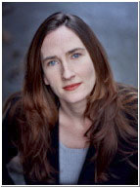
Dr. Wrye Sententia teaches at the University of California, Davis and serves on the technology ethics advisory board for the Nanoethics Group. In addition to her nonprofit work on the policy and ethics of freedom of thought in an age of neurotechnology, she currently teaches both for the UC Davis Technocultural Studies Program and the University Writing Program.
